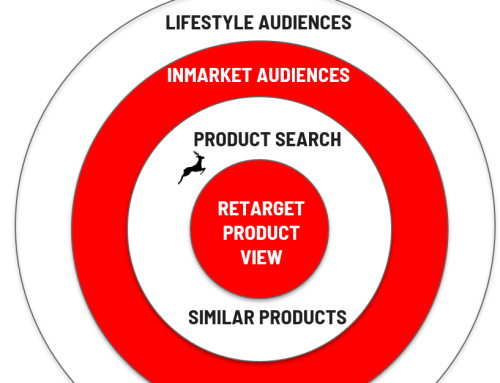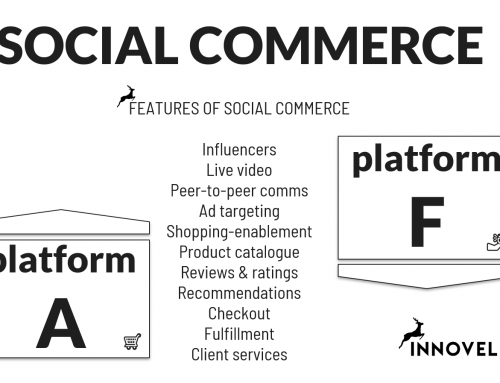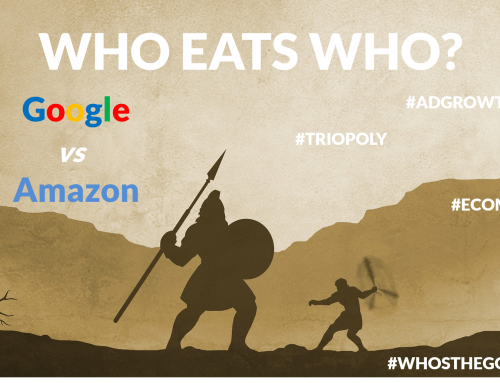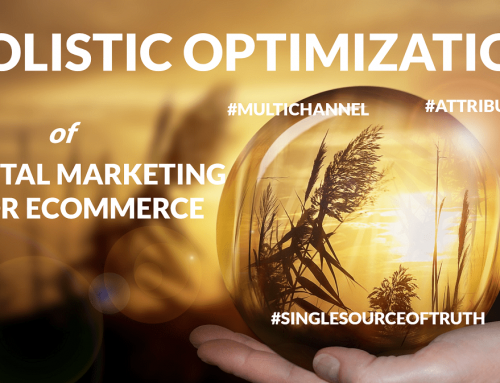“OMG, Anders, PPC Performance was awful over the weekend ” 😲😱
“How can we get our paid search and shopping campaigns back on track?” 🙄
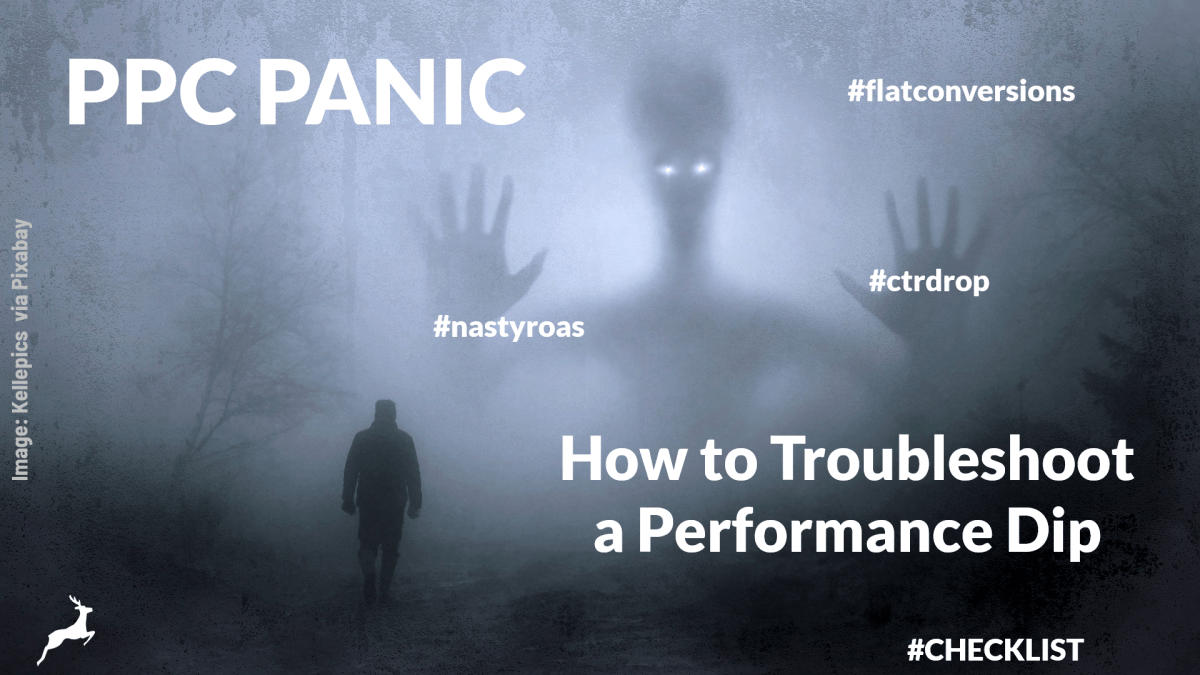
The PPC Panic List
Before the weekend, I had been in discussions with Norman (not his real name) and his team about a PPC benchmark of their US, UK and FR operations against the cluster of leading PPC agencies we analyzed for the Search Marketing Trends Report. The benchmark analyzes the 5 dimensions of digital marketing maturity established by Boston Consulting Group in the 5A’s framework: Audiences, Assets, Automation, Attribution and Access.
But the message from Norman this morning called for something else. He was clearly struck by extreme PPC Panic, and the question was no longer whether the agencies and the internal operation were set up for success, it was about correcting campaign flaws that had put the entire operation at risk.
I drafted t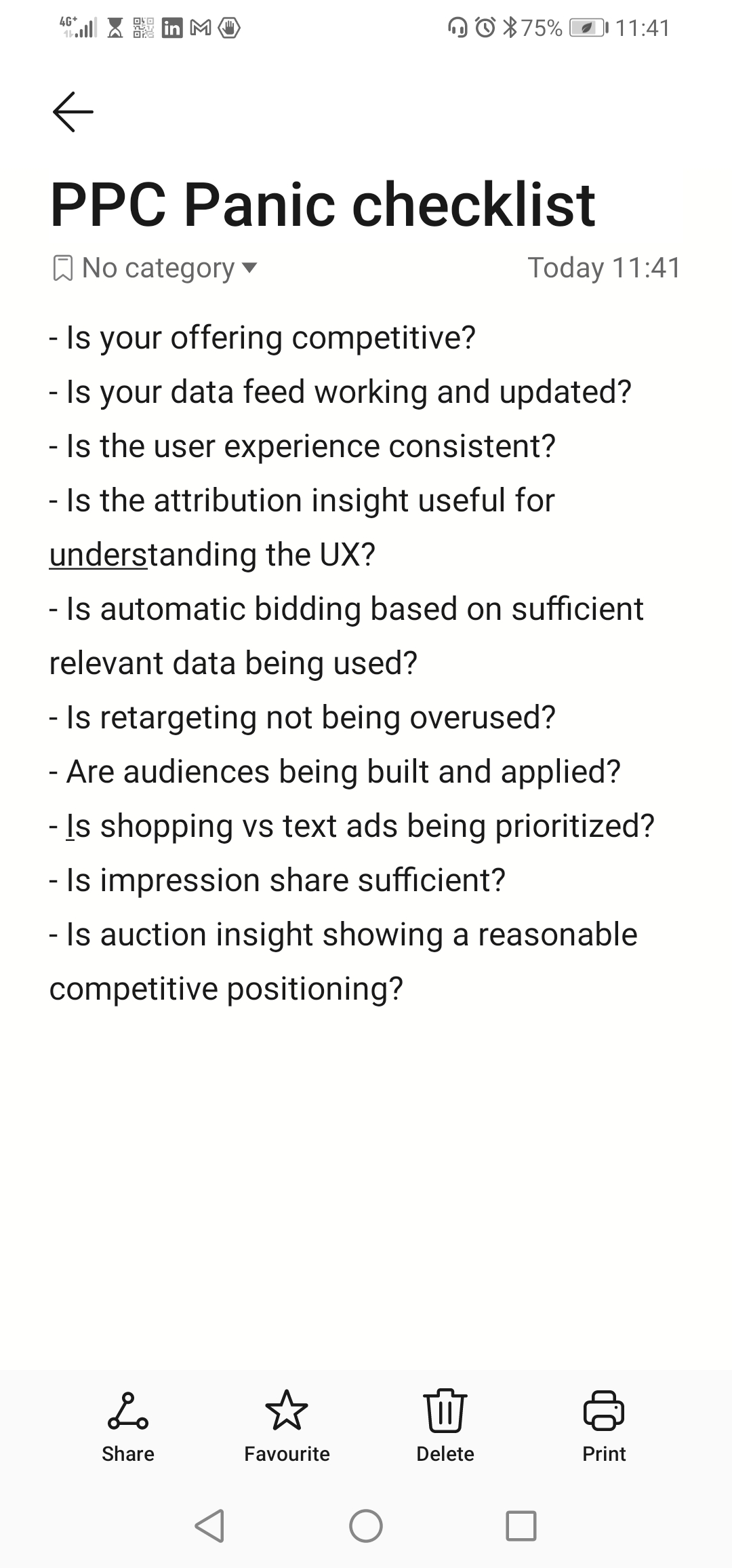 he following PPC Panic list off the top of my head. I considered what I would have done if it were me waking up that day and missing performance targets massively on a budget of hundreds of thousands.
he following PPC Panic list off the top of my head. I considered what I would have done if it were me waking up that day and missing performance targets massively on a budget of hundreds of thousands.
PPC Panic checklist (original but numbered)
- Is your offering competitive?
- Is your data feed working and updated?
- Is the user experience consistent?
- Is the attribution insight useful for understanding the user experience?
- Is automatic bidding based on sufficient relevant data being used?
- Is retargeting not being overused?
- Are audiences being built and applied?
- Is shopping vs text ads being prioritized?
- Is impression share sufficient?
- Is auction insight showing a reasonable competitive positioning?
I realized afterwards, that a few of these may need a bit more explanation to be useful. It is not a yes/no check list, it is a list of items to go through within a context. Additionally, there is no prioritized order in the list.
Is the user experience consistent?
My favourite starting point is point number 3: Is the user experience consistent? I think this is the most important task of any marketer: create consistency in the user journey. Make it clear where you are taking users in every step of the journey. This is about putting yourself in the user’s shoes and going through the marketing steps one by one, imagining use cases, touch points and interactions. It is not an easy exercise because communication channels and advertising have become so fragmented. When advertising was in its infancy, in the days of “Mad Men”, it would be aimed at creating one strong message and repeating it. In today’s digital era, it is about creating a strong and clear direction and weave partial messages into the path in a consistent manner to build a complete understanding and a frictionless interaction towards the end goal.
The Top25 PPC’ers additions
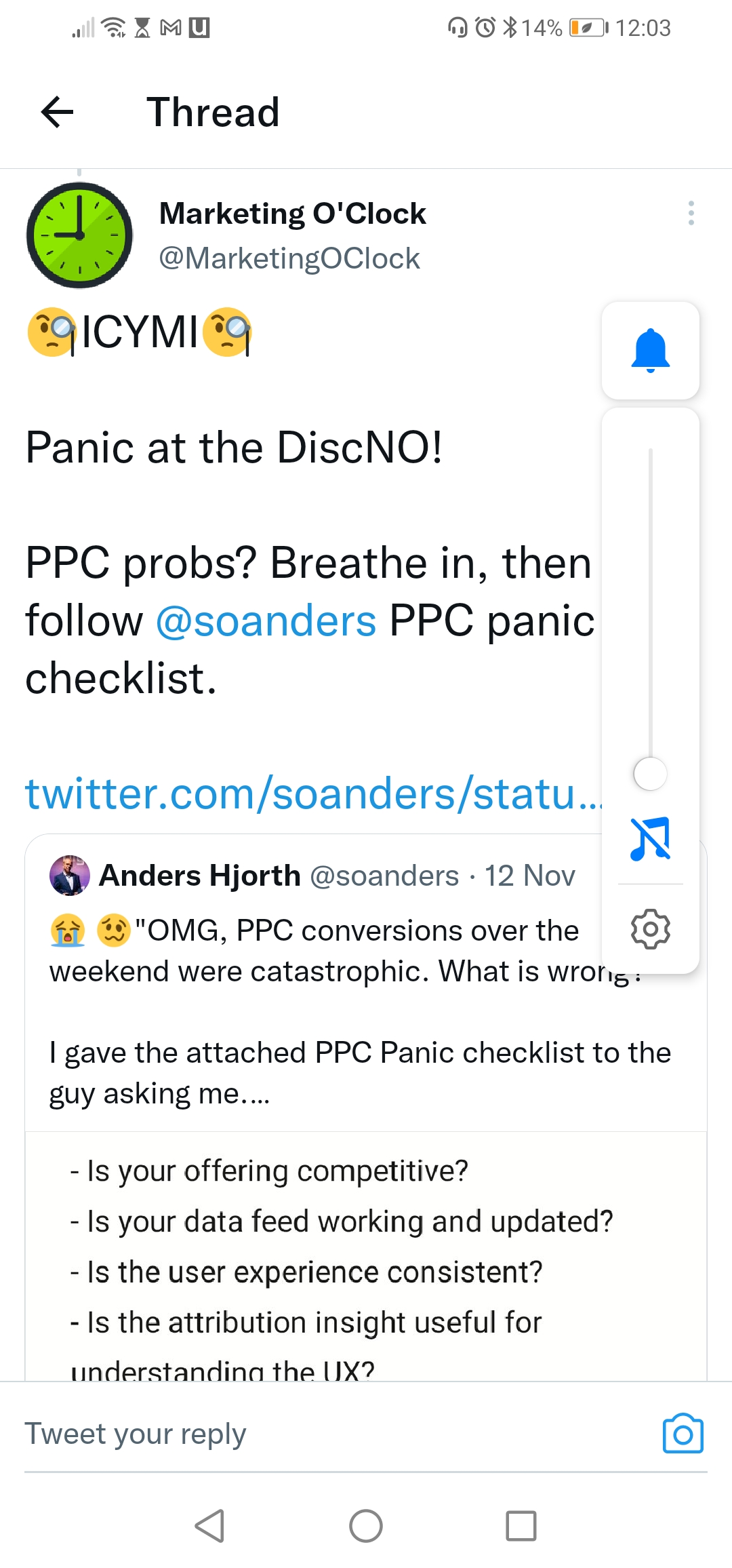 After sharing with Norman, I went on to activate that magical value catalyzer for digital marketing knowledge: the PPC community around the Paid Search Association and #PPCChat on Twitter, many of its participants are on the list of Top 25 most influential PPC Experts in 2021. During the day, the Twitter thread was quite animated and the initial checklist was augmented by a number of PPC specialists that I greatly respect and enjoy exchanging with. The Marketing O’Clock team seems to have picked up the conversation too.
After sharing with Norman, I went on to activate that magical value catalyzer for digital marketing knowledge: the PPC community around the Paid Search Association and #PPCChat on Twitter, many of its participants are on the list of Top 25 most influential PPC Experts in 2021. During the day, the Twitter thread was quite animated and the initial checklist was augmented by a number of PPC specialists that I greatly respect and enjoy exchanging with. The Marketing O’Clock team seems to have picked up the conversation too.
In the PPC community, Navah Hopkins was fastest on the keyword. It may be a time-zone thing or it may just be a personal trait. Thanks Navah for being fast and incisive. She added a few interrogations: is the problem real? Is everything working as it should?
One of her first additons was to check date settings to make sure of the reality of the reason for panic. Are you looking at the right time frame? Could it be that conversions are simply delayed due to a long decision or reporting cycle? Are their multiple and conflicting objectives that draw results in the wrong direction?
From a more technical point of view, she also indicates a couple of check points: location targeting, auto-apply, the landing page. An eye-opener for me was “auto-apply“, a functionality were the ad engine will kindly apply changes to your campaign automatically as it sees fit. Go put your brains in the cupboard, they are no longer needed!
After Navah’s tweet, more recommendations rolled in. Kirk Williams sounds like he has been confronted with this type of situation many times before. The most common reason he encounters is that tracking is down: “Did you check the conversion pixel and check that conversion tracking is still working as it should be?”
Never make changes on a Friday
Kirk and his team have had their share of PPC Panic messages from clients, and after the first check on the reality of the problem, their next checkpoint is the following: “Did your dev/design team make any changes to PDPs or the checkout experience, or anything else that could impact UX?”.
This reminded me of one of the golden rules of digital marketing which I have always tried to live by: “Never make changes to your website on a Friday”. This includes minor tracking, UX or plugin updates that are seemingly harmless. Want to quickly get those changes implemented before you leave on weekend? Don’t do it!
I am thinking this rule actually might apply to other situations in life. Making hurried or not thoroughly tested changes to a system that will keep running while you are away is not something I would recommend. Probably not something they do in nuclear power plants or in payment verification systems, and I am thinking water supply infrastructure and gas pipes maintenance probably have similar golden rules they apply.
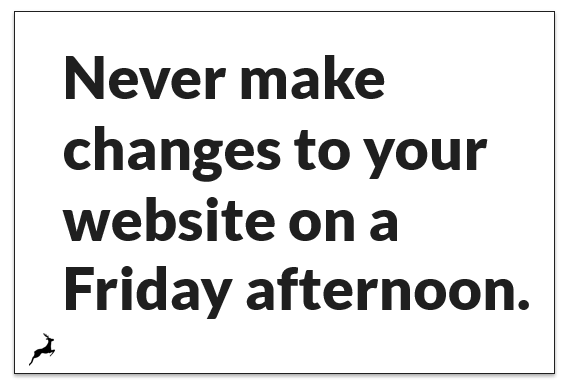
Is campaign data flowing as it should?
Mike Ryan provided a quick three-step verification in “feed, budget and changelog“, but also mistakenly called it a “cute over-the-weekend scenario” which it clearly wasn’t 😲. I make tweet typos all the time too. Hate that you can’t correct a tweet once it flies, but I know it is part of the Twitter deal: Fast and as-is. The “feed” that Mike mentions corresponds to the point 2 in the original list: 2. Is your data feed working and updated?
A data feed is typically an ongoing process in which data from a product catalog is being fed into an advertising system. The process can be a manually built system or it can be based on a tool. Once it is up and running, it is part of the magic of real-time advertising, as a products most recent information including, price, stock level and product images is provided into the advertising system. The downside is of course that it is magical when it works but it is a horror story if it stopped working and you’ve ended up offering a Halloween promotion for Easter. By going through some of the user experience testing mentioned earlier, you may be able to pinpoint this type of problem, but another approach is of course to check the data flow to make sure the latest and correct data is in the data feed and received correctly in the advertising systems.
A great additional check from Julie Bacchini is to verify for any outages on the platforms over the weekend. Platforms failing to stay up or provide complete data has become a more frequent problem these past years.
The Ultimate PPC Performance Panic List
Starting with a top of mind list and adding some great input from the PPC community, let us now review and reorder the list so that those in panic can get a structured and well through-through action list to work by. Through the various inputs, it becomes quite clear that the check points can be grouped in specific areas and prioritized to form a step by step list. I therefore dare to call this the Ultimate PPC Performance Panic list and will accept to update with any missing advice that is shared with me over time so this can remain applicable and to the point. I want to assist victims who have been struck by PPC misfortune over the weekend, during the night or perhaps when the manager was off on vacation.
The prioritized 5 steps to go through in case of PPC Panic.
- Reality check. Is the panic justified? (pixels, dates, reporting updates, data delays)
- Waterproof check. Is your operation intact or is there a leak (feed, site, certificate, payment process)
- Environment check. Is there a force majeure (pandemic, climate catastrophe, monetary crash, shitstorm, …)
- Consistency check. Is what you are advertising consistent
- Pulse check. Are your campaigns live and in shape?
Let’s go through each of them to see what they are all about.
First step: Reality check
With a little luck you can calm the panic before going much further in the list. You panic because the results you are seeing are way worse than what you expected to see. But are you looking at the right data set?
- Check that you are looking at the right dates and that they are comparable with your baseline.
- Check that your pixels are in place to track the data you are measuring. Check any website updates that were done recently and shouldn’t have been implemented on a Friday.
- Check that the reporting interface you are looking at has been updated. Maybe go back to the source data and check for consistency.
- Check for data delays. Could it be that the results you are expecting to see have not yet produced the desired and measurable outcome.
I am so much hoping that you found the glitch in the above points and that reality is not as bad as you first thought. If that is not the case, move one to a more in-depth check up on your system in the next step.
Second step: Waterproof check
We have concluded that the data we are seeing is not showing the results we hoped to see. In this second step we therefore dive deeper to check whether or not the entire advertising system is watertight, or whether some element of it has stopped functioning. If the results we are seeing are real, we are hoping to find a simple flaw to fix in this step.
- Check that data feeds are updated and arrive in the right location.
- Check that the secure server certificate has not expired and that the site is up and running. Why not check domain name expiry dates at this point.
- Check for any signs that your site has been hacked.
- Check that the payment system is up and running.
- Check that the campaign landing pages are functional.
Although at this point you know you have lost performance, we are hoping that one of the above reasons can explain the drop and that fixing it will get you back on track quickly. If you didn’t find any explanation in the above points, then let’s move on to the third step to check for environmental explanations.
Third step: Environment check
We are now pretty certain that the lost performance is real and that the advertising is technically up and mechanically running the way it is supposed to. No quick fixes seem to present themselves to us and we must look outside the box for reasons for the drop. Here are some of the things to check for.
- Did any pandemic just hit your target audience?
- Any climate situation that could explain a sudden change in user behaviour?
- Is the economic situation stable or are households suddenly scared of a stock exchange crash, is inflation ramping, have there just been austerity announcements from the Prime Minister?
- Closer to your brand, was there a shitstorm on social media or did one of your competitors just get an award for strongest brand or best place to work?
Some changes in the environment can strongly affect a campaign. They may have arrived suddenly but have the potential to change user behaviour in depth either for the short or the long run. They affect strategy and if they are at play, you may be best off reducing spend and reviewing what impact they may have on the way users find, consider, select and buy your products. If you haven’t been able to identify external factors to explain your performance drop, it will be time to look for the worm inside the apple. Let’s get digging.
Fourth step: Consistency check
In many cases, I am the alert and well-organized marketer, so I might jump straight to the consistency check. I would have felt or even avoided that any of the first three steps would affect my campaigns. Consistency is quite subjective and hard to see. Inconsistency, however, stands out quite clearly when you meet it. This consistency check is about putting yourself in the users’ place and experiencing your marketing as the target audience receives it. Here are some of the things you might undertake in that process:
- Go to sites you have targeted for advertising and try to get a glimpse of your own ads. This is not always possible because digital advertising targets users rather than sites today.
- Try to mimick user behaviour and characteristics of your target audience. Search as they do, browse as they do, simulate using the language and location they are in. Are your ads triggered and do they make sense?
- Take screenshots of your own ad occurences, click on them, screenshot your landing page for documentation. Does it all make sense?
- After clicking through on the advertising, go through the user journey towards the purchase. Take screenshots again and anything creating friction or confusion, and obviously anything blocking your path.
- You ran into some competitors along the path. Were they doing promotions like it is the end of the world? Is your offering competitive?
- For each of your advertising channels, go through the above exercise to check and confirm consistency in the user journey.
You may not find one single point blocking your way to fulfill the user journey and purchase your own products, but in many cases you will find a number of points where you can improve the user journey with your messaging or imagery. You may also be able to build a number of hypothesis for what might be wrong with your campaigns. Some of them could lead to resolution and others simply to better performance or new audiences ot reach. Regardless of the level of troubleshooting you have done in this point, you should probably complete your checklist by going through the last step.
Fifth step: Pulse check
I have called the last step in this process the pulse check. In many cases, what we are looking for is whether there are any signs of performance in the campaign. Is there a pulse? The pulse check is in reality a small PPC audit and it has the potential to take your campaign to the next level. I really like the detailed walk-through of an account audit shared in this thread by Amalia Fowler. She divides the audit into seven sections: Objectives, Account structure, Campaign targeting and Keywords and match types, Ads, Changelog, Display and audiences. Find a run through by Amalia in this thread.
In the following list I have incuded a number of the points uncovered by Amalia and the PPC community on Twitter. If you feel it is incomplete, don’t hesitate to suggest additions:
- Correspondence of tracked goals with objectives
- Account settings: conversion, attribution, account integrations
- Usage of extensions: using what make sense and not what doesn’t?
- Account structure: campaigns, adgroups, keywords.
- Smart bidding and consistency with data volumes and outcome
- Audiences: do they make sense? Do they add value?
- Retargeting (audiences): are you doing it and not overdoing it?
- Geolocation settings
- Auto-apply settings
- Impression shares and auction insights: what is the competitive setting?
At this stage you have hopefully identified what was not working with your campaign in this instance. You have also started undertaking a number of auditing measures which can help you avoid PPC Panic in the future and contribute to your campaign performance overall.
Strategy, governance and a clear process will help you reduce the likeliness of panic coming your way.
PPC performance has been something quite predictable for many years but it is becoming more volatile. This is caused both by more rapid user behaviour changes and by the increased share of machine-learning and AI in media optimization. The more you rely on automation and tools, the less visibility and end-user insight you get. This makes it more difficult to take corrective action once something goes wrong. The more automation, the more opacity. This is where PPC strategy implemented by human pilots and enhanced by automated processes and AI will be the ideal way to manage digital advertising in the future.
Please contact me via Twitter for any additions to this list. I am happy to update it to include all the best tips and tricks for getting through PPC panic and restoring campaign performance.
Stay tuned on the Innovell blog and subscribe to the Innovell newsletter if you want to learn how the landscape evolves and how marketers adapt to this ongoing change 🙂


